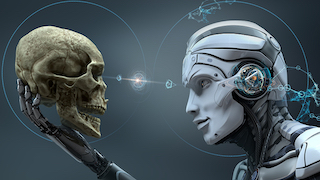 Two new studies published in the Journal of Biological Psychiatry and BioRxiv focused on understanding how the frontal part of the cortex known as the prefrontal cortex (PFC) develops.
Two new studies published in the Journal of Biological Psychiatry and BioRxiv focused on understanding how the frontal part of the cortex known as the prefrontal cortex (PFC) develops.
“We were interested in studying this regions as it is important for higher order cognition (think problem solving, planning complex actitivies), regulating emotion and social behaviors, which are most advanced in humans and behaviors disrupted in most neuropsychiatric disorder,” studies author Kartik Pattabiraman told us. “Furthermore, the PFC is greatly expanded in primates and are further specialized i.e. unique connections and cellular properties in humans. For example, excitatory neurons in human PFC form more connections with other neurons than neurons in monkeys and other animals.”
Researchers were hoping to find out two things. 1) What are molecular/genetic mechanism required for the PFC to acquire its identity/properties that separate from other regions of the cortex. 2) What are the mechanisms underlying specialization of the human PFC?
“We hypothesized that answering these questions would provide essential insights into what makes us human and why we develop neuropsychiatric disorders like autism and schizophrenia,” Pattabiraman told us.
Based on previous research in Sestan and other labs, researchers proposed that the molecular processes involved identity acquisition and specialization of the human PFC where occurring during the second trimester of pregnancy. Specifically, they would identify genes enriched in the PFC during the second trimester that would provide clues into what is going in the PFC during that period of development.
“We are interested in what makes us human? What are the biological processes that are disrupted in neuropsychiatric disease? Both of these questions point to the PFC, as it is greatly expanded and specialized and associated with most neuropsychiatric disorders,” Pattabiraman told us. “Furthermore, previous data suggests that the second trimester of development is a particularly sensitive period of development to genetic mutations that cause developmental disorders.”
To test this theory, researchers used existing human developmental data to identify genes enriched in the front of the brain during the second trimester of development. They identified a unique gene signature associated with processes involved in forming connections in the brain and retinoic acid, a vitamin derivative essential for various processes in development.
Comparative analyses between human, macaque and mouse identified the production of retinoic acid is tightly restricted to the PFC during the second trimester and that retinoic acid production is greatly expanded in monkeys/humans during this period. This expansion of retinoic acid closely mirrors the expansion of the PFC in primates and could be a possible evolutionary mechanism for this expansion.
“Furthermore, we tested the function of PFC retinoic acid function by testing what happens if you specifically reduce retinoic acid during development,” Pattabiraman told us. “We found that there were very specific changes in the way the PFC form connections especially in the formation of connections with thalamus, which are essential for working memory/higher order cognition and disrupted in schizophrenia. Furthermore, expanding retinoic acid activity in developing mouse brain similar to the pattern in monkeys/humans alter connections in the frontal of brain partially similar to changes in the monkey/human brain.”
In the second paper, researchers looked at a gene CBLN2 which was the gene most enriched in the front of the brain and controlled by retinoic acid. This gene is known to be important for forming connections in brain.
“We found that this gene is less expressed in the mouse and macaque compared human during a short period of development,” Pattabiraman told us. “Through genomic analysis, we identified two small deletions that occurs in the human and chimpanzee genome in a region that controls CBLN2 expression in the PFC.”
Replacing the mouse genomic region with the human genomic sequence with the deletions lead to increase in CBLN2 expression similar to the human expression and a 30% increase in brain connections in the adult mouse brain, which is also more similar to human pattern of connections.
“We were surprised by the role of retinoic in these processes,” Pattabiraman told us. “Retinoic acid was associated with very early cortical development but not later cortical development. Furthermore, retinoic acid is essential for so many developmental processes, thus we were amazed by the very specific changes in the way the PFC connects.”
For the second paper, researchers were surprised that such a small change in the sequence of the genome (200 base pairs from 3 billion) could underlie one of the specializations in the brain that make us human.
“We believe we have identified the beginning of the gene network that may be essential for the behaviors most advanced in humans and that may be disrupted in psychiatric disease,” Pattabiraman told us. “We are interested in further elucidating this network to understand other mechanisms involved in formation and specialization of the human brain. In addition, we are interested understanding how disruption of the network could lead to neuropsychiatric disorders.”
Patricia Tomasi is a mom, maternal mental health advocate, journalist, and speaker. She writes regularly for the Huffington Post Canada, focusing primarily on maternal mental health after suffering from severe postpartum anxiety twice. You can find her Huffington Post biography here. Patricia is also a Patient Expert Advisor for the North American-based, Maternal Mental Health Research Collective and is the founder of the online peer support group - Facebook Postpartum Depression & Anxiety Support Group - with over 1500 members worldwide. Blog: www.patriciatomasiblog.wordpress.com
Email: tomasi.patricia@gmail.com